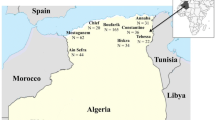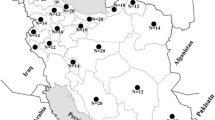Abstract
A gene-enzyme analysis was carried out on the honeybee miteVarroa jacobsoni. By means of gel electrophoresis, 17 presumptive gene loci, belonging to 14 enzyme systems, were scored. Adult female mites were collected in 12 apiaries from European countries and in one apiary from Beijing (China). The populations analysed were monomorphic for all the loci considered, almost all the individuals being homozygous for the same alleles. The breeding system and stochastic mechanisms during the spread ofV. jacobsoni over the world may account for the uncommonly low level of genetic variability observed. The genetic identity found among the analysed samples suggests that taxonomic differentiation is absent even among mite populations living in the different honeybee races considered.
Similar content being viewed by others
References
Avise, J.C., 1975. Systematic value of electrophoretic data. Syst. Zool., 23: 465–481.
Ayala, F.J., 1983. Enzymes as taxonomic characters. In: G.S. Oxford and D. Rollinson (Editors), Protein Polymorphism: Adaptive and Taxonomic Significance. Academic Press, London, pp. 3–26.
Biasiolo, A. and Comparini, A., 1989. Electrophoretic analysis of gene-enzyme systems inVarroa jacobsoni Oud.: preliminary results. In: R. Cavalloro (Editor), Present status of Varroatosis in Europe and progress in theVarroa mite control. Proc. E.C. Experts' Group Meeting, Udine, 1988. C.E.C., Luxembourg, pp. 207–211.
Camazine, S., 1986. Differential reproduction of the mite,Varroa jacobsoni (Mesostigmata: Varroidae), on Africanized and European honey bees (Hymenoptera: Apidae). Ann. Entomol. Soc. Am., 79: 801–803.
Carson, H.C. and Templeton, A.R., 1984. Genetic revolutions in relation to speciation phenomena: the founding of new populations. Ann. Rev. Ecol. Syst., 15: 97–131.
Cavalloro, R., 1989. Current situation of varroatosis infestation and control. In: R. Cavalloro (Editor), Present status of Varroatosis in Europe and progress in theVarroa mite control. Proc. E.C. Experts' Group Meeting, Udine, 1988. C.E.C., Luxembourg, pp. 15–17.
Chiesa, F. and Milani, N., 1988. Some preliminary observations on the behaviour ofVarroa jacobsoni Oud. on its natural host under laboratory conditions. In: R. Cavalloro (Editor), European research on varroatosis control. Proc. E.C. Experts' Group Meeting, Bad Homburg, 1986. A.A. Balkema, Rotterdam, pp. 113–124.
De Jong, D., Roger, A.M. and Eickwort, G.C., 1982. Mites pest of honey bees. Annu. Rev. Entomol., 27: 229–252.
Delfinado-Baker, M., 1988. Variability and biotypes ofVarroa jacobsoni Oudemans. Am. Bee. J., 128: 567–568.
Delfinado-Baker, M. and Houck, M.A., 1989. Geographic variation inVarroa jacobsoni (Acari, Varroidae): application of multivariate morphometric techniques. Apidologie, 20: 345–358.
Fava, G., 1988. Uso di varianti enzimatiche come marcatori genetici. Agricoltura delle Venezie, Vol. XLII: 579–581.
Ferguson, A., 1980. Biochemical Systematics and Evolution. Blackie, Glasgow, 194 pp.
Fuchs, S., 1988. The distribution ofVarroa jacobsoni on honeybee brood combs and within brood cells as a consequence of fluctuation infestation rates. In: R. Cavalloro (Editor), European research on varroatosis control. Proc. E.C. Experts' Group Meeting, Bad Homburg, 1986. A.A. Balkema, Rotterdam, pp. 73–76.
Greatti, M., Milani, N. and Nazzi, F., 1992. Reinfestation of an acaricide-treated apiary byVarroa jacobsoni Oud. Exp. Appl. Acarol., 16: 279–286.
Griffiths, D.A. and Bowman, C.E., 1981. World distribution of the miteVarroa jacobsoni, a parasite of honeybees. Bee World, 62: 154–163.
Griffiths, D.A., Gray, J. and Peagazzano, F., 1983.Varroa — The acarologists' view. In: R. Cavalloro (Editor),Varroa jacobsoni Oud. affecting honey bees: present status and needs. Proc. E.C. Experts' Group Meeting, Wageningen, pp. 79–83.
Hamilton, W.D., 1967. Extraordinary sex ratios. Science, 156: 477–488.
Helle, W. and Overmeer, W.P.J., 1973. Variability in tetranychid mites. Annu. Rev. Entomol., 18: 97–115.
Johnson, G.B., 1977. Assessing electrophoretic similarity. The problem of hidden heterogeneity. Annu. Rev. Ecol. Syst., 8: 309–328.
Koeniger, N., Koeniger, G. and Delfinado-Baker, M., 1983. Observations on mites of the Asian honeybee species (Apis cerana, Apis dorsata, Apis florea). Apidologie, 14: 197–204.
Mather, K., 1973 Genetical Structure of Populations. Chapman and Hall, London, 196 pp.
Nei, M. and Li, W.H., 1975. Probability of identical monomorphism in related species. Genet. Res., 26: 31–43.
Nevo, E., Beiles, A. and Ben Schlomo, R., 1984. The evolutionary significance of genetic diversity: Ecological, demographic and life history correlates. Lect. Notes Biomath., 53: 13–213.
Peng, Y.-S., Fang, Y., Xu, S. and Ge, L., 1987. The resistance mechanism of the Asian honey bee,Apis cerana Fabr., to an ectoparasitic mite,Varroa jacobsoni Oudemans. J. Invertebr. Pathol., 49: 54–60.
Rademacher, E., 1990. Die Varroatose der Bienen. Geschichte, Diagnose, Therapie. Schelzky and Jeep, Berlin, 149 pp.
Rosenkranz, P., Issa, M., Rachinsky, A., Strambi, A. and Strambi, C., 1989. Honeybee-Varroa relationships: a comparison of africanized and carniolan colonies. In: R. Cavalloro (Editor), Present status of Varroatosis in Europe and progress in theVarroa mite control. Proc. E.C. Experts' Group Meeting, Udine, 1988, C.E.C., Luxembourg, pp. 193–198.
Ruttner, F., 1988. Biogeography and Taxonomy of Honeybees. Springer Verlag, Berlin, 284 pp.
Ruttner, F. and Maul, V., 1983. Experimental analysis of reproductive interspecies isolation ofApis mellifera L. andApis cerana Fabr. Apidologie, 14: 309–327.
Sakofski, F., 1989. Transfer ofVarroa jacobsoni by robbing. In: R. Cavalloro (Editor), Present status of Varroatosis in Europe and progress in theVarroa mite control. Proc. E.C. Experts' Group Meeting, Udine, 1988. C.E.C., Luxembourg, pp. 177–181.
Author information
Authors and Affiliations
Additional information
This research was supported by the Institut Technique de l'Apiculture (ITAPI), Bures-Sur-Yvette, France.
Rights and permissions
About this article
Cite this article
Biasiolo, A. Lack of allozyme variability amongVarroa mite populations. Exp Appl Acarol 16, 287–294 (1992). https://doi.org/10.1007/BF01218570
Issue Date:
DOI: https://doi.org/10.1007/BF01218570




